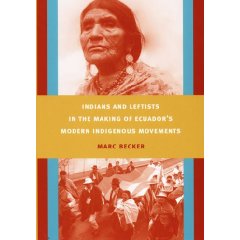
| The Book |
| Chronology |
| Acronyms |
| Glossary |
| Biographies |
| Revolts |
| Documents |
| Data |
This is an Electronic Appendix of documents to accompany my book Indians and Leftists in the Making of Ecuador’s Modern Indigenous Movements (Duke University Press, 2008).

Journal of Interdisciplinary History 40, no. 1 (Summer 2009), 134-35.
Indians and Leftists in the Making of Ecuador’s Modern Indigenous Movements. By Marc Becker (Durham, Duke University Press, 2008) 303 pp. $79.95 cloth $22.95 paper
One of the most remarkable success stories of the late modern era is the Ecuadorian indigenous movement. In this fascinating, slightly uneven, work comprised of eight chronologically ordered chapters, Becker brings a refreshing addition to a growing body of literature. What stands out is not only his employment of a variety of methods drawn from a multitude of social scientific disciplines—archival research, participant observation, interviews, and discourse analysis—but also his unwavering commitment to building an argument rather than unrolling a simple historical narrative.
Becker constructs his argument by characterizing the 1990 Ecuadorian indigenous uprising—details of which he provides in the final chapter—as “a tectonic shift with important consequences for the nature of popular organizing efforts across Latin America” (1). However significant this uprising may have been, it did not represent “the birth, but the culmination of years of organizing efforts that introduced innovative strategies and discourses to advance Indigenous rights and preserve ethnic identities” (3). These key organizational years did not start in 1964—the year often cited as the beginning of indigenous political organizing in Ecuador, when the lowland Shuar Federation was formed—but rather in 1944, when the Ecuadorian Indian Federation (FEI) became the first organization “for and by Indigenous peoples in Ecuador” (12). The FEI survived into the 1980s until it was replaced by the Confederation of Indigenous Ecuadorian Nations (CONAIE), the preeminent hub anchoring an ever-growing multiplicity of indigenous and al- lied organizations. Becker draws some of his insights from the CONAIE’s own historical narratives.
Through meticulous historical documentation and ethnographically grounded interviews, Becker discovers not only that Ecuadorian indigenous movements had a longer history than commonly supposed but also that the FEI’s original foci and ongoing platform centered squarely around issues of importance to Ecuador’s native peoples—labor reform, agrarian reform, and both redistributive and ethnic justice. Becker contests suggestions that the FEI was little more than a front for the Ecuadorian Communist Party” (PCE). Instead, he argues that leftist influences helped to bring indigenous concerns to a broader national and international stage and to “trigger a shift in Indigenous strategies from reacting to local and immediate forms of exploitation to addressing larger structural issues” (12). Becker’s feminist-oriented attention, throughout the book, to the role of women in forming these alliances and working on behalf of the FEI and subsequent indigenous movements is an additional strength of the work.
Becker makes the cogent suggestion that, in contrast to Peru, “out of a weak indigenista [non-Indian nationalist idealization of indigenousness] movement a strong Indigenous movement emerged in Ecuador” (86). His research and discussion of the indigenous protests that took place on state-owned haciendas in the Cayambe region in the early twentieth century is especially impressive. Yet, despite his deep historical and comparative insights, the work suffers from a few problems, the most serious being Becker’s overwhelmingly positive treatment of the PCE and FEI, which at times hints more of apology and straw-man construction than analysis. Moreover, Becker might have done well to examine Ecuador’s recent history—from 1990 to the present—in a separate volume rather than in a single, long chapter at the end of this book. The detailed chronology of Indigenous activism that opens the book, however, is worth the price alone, along with the final two sentences: “Indigenous organizations never made a clean break with their leftist past, nor have urban leftists discarded a long reliance on ethnic discourse. Nor would there be any clear purpose for doing so” (193).
Kathleen S. Fine-Dare
Fort Lewis College